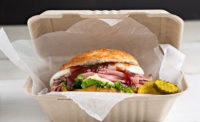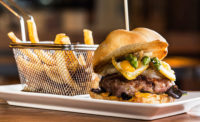Formulation Strategies
Lunch trends: Consumers' snacking habits move into lunch




At the retail deli counter, lunchmeat has always been the cornerstone of what makes its way into lunchboxes, until recently. The
$9 billion industry, which includes deli and packaged lunchmeat with $5 billion coming specifically from the deli department, lunchmeat is showing signs of struggle as consumers change the way they eat, especially around lunch, says Sarah Schmansky, vice president of Nielsen Fresh, Chicago.
Turkey and ham continue to reign supreme in terms of what’s most popular within lunchmeat, Nielsen data reports. While overall sales of lunchmeat are down, growth is occurring in turkey, ham (although minimal), as well as varieties such as salami and pepperoni (up 3.5 percent and 4.5 percent in dollars, respectively for total U.S. deli lunchmeat for the year ending Feb. 24, according to Nielsen).
“We’re also seeing growth in flavors that add some spice to your palette, as well as non-traditional lunchmeat,” Schmansky says. For example, bold turkey is up more than 5 percent, and black forest ham up 4 percent. Pepperoni, mortadella and pancetta also are all up around 5 percent for the year ending Feb. 24.
Snacking is likely the biggest consumer trend affecting the performance of lunchmeat.
“More and more consumers are foregoing the option of making a sandwich and perhaps even forgoing lunch all together and instead having smaller, more frequent meals throughout the day,” Schmansky says.
This provides a great growth opportunity for specialty deli meat, which is the only deli lunchmeat category that is growing in dollars (up 2.2 percent) and doesn’t have a loss in volume (flat vs. a year ago), Nielsen data show. Products within specialty deli meat are those that can be cut up or sliced for snacking, stick pepperoni/sausage and more premium varieties, such as Italian meats and chorizo.
Another trend based off the changing consumer is the need for quick, fresh, healthy offerings.
“We see great opportunity for the lunchmeat category to increase more effective efforts in touting its health benefits to drive consumer education and awareness,” Schmansky says. “Healthful products and those with health claims are growing across the store, and lunchmeat needs to leverage to gain appeal.”
In fact, healthful claims attached to lunchmeat currently are showing signs of growth. For example, antibiotic-free is up 9 percent, all-natural grew 3.7 percent and clean and simple rose 5 percent, Nielsen reports for the year ending Feb. 24.
Convenient offerings also must be available for lunch. “You can see how this is evolving with the significant growth of deli-prepared foods over the last five to six years,” Schmansky says. “Retailers are finding a way to grab the consumer who is out for lunch and maybe has to grab some groceries for the evening/rest of the week, and deli-prepared is winning because of it.”
The deli-prepared foods category is up 2.5 percent, and items such as deli soups, breakfast foods, sushi and entrees are driving the growth. Nielsen reports, however, deli sandwiches are only up 1 percent in dollars yet down 1.6 percent in volume for the year ending Feb. 24.
“Lunchmeat has somewhat found its niche within the grab-and-go deli lunchmeat section,” Schmansky says. “These products that are sliced ahead of time and placed in a refrigerator for quick access and no waiting in line are growing significantly. At 11 percent of total deli bulk meat sales, grab-and-go varieties generate $456 million in sales and have increased 27 percent in dollars and volume over the last year.”
Private-label offerings are the largest contributors of these grab-and-go lunchmeat items; however, some brands are seeing growth as well, Schmansky says. As previously mentioned, specialty deli meat and cheese also can be a grab-and-go option for the time-strapped consumer wanting to add protein to their diet on their lunch break, she adds.
As far as innovation goes, Nielsen Fresh sees it more within deli prepared foods and the snacking offerings that may include deli lunchmeat — charcuterie plates, for example — but not featuring deli lunchmeat in its entirety. Alternatively, seafood companies are stepping up and showing how they can offer convenient and grab-and-go products with the introduction of Seafood Poke bowls as well as grab-and-go items such as shrimp cocktail, Schmansky says.
Moving forward, Schmansky expects to see deli-prepared food offerings become more sophisticated and easy to obtain whether through delivery options or curbside pick-up.
“Retailers have a significant challenge when it comes to driving consumers in store during this meal time when there are so many options available that provide quicker and likely healthier lunchtime offerings for today’s busy consumer,” she adds.
Lunching out
Lunch is the only daypart that drives more diners during the week versus the weekend, according to Mintel’s Dining Out Dayparts US report, published in October 2017. Forty-three percent of respondents to Mintel’s meal occasions survey said they regularly dine out for lunch during the week, followed by 36 percent saying they regularly dine out for lunch on the weekends.
Quick-service restaurants have a strong hold on the weekday lunch with 42 percent of employed weekday lunch diners regularly eating lunch at quick-service restaurants, Mintel found. This demonstrates the importance of low prices and convenience during the weekday, the research firm says.
Roughly one-third of diners’ last meat or poultry occasions took place at lunch, and one-third of all last occasions were lunch-friendly burgers or sandwiches, reports Datassential, Chicago. While the research firm did not drill down into those lunch occasions by protein variety, overall it found that chicken or beef were the most commonly consumed, with each representing about 40 percent of occasions. Bacon followed. Interestingly, given the number of meat and poultry varieties included, at least some of those items appear to have included more than one animal protein, such as an Italian sub with multiple meats or a bacon burger, says Jackie Rodriguez, Datassential’s senior project manager.
When asked how often they eat the following, 62 percent of consumers reported they eat beef at least once a week either at home or in restaurants for lunch, reports Technomic, A Winsight Company, Chicago, in its 2017 Center of the Plate report. Pork, with 48 percent of consumers, was the next most widely consumed for lunch, which was up from 42 percent in 2014. Chicken and turkey followed with 44 percent and 35 percent, respectively.
In the 2017 Center of the Plate report, Technomic saw a slight decline in the average number of beef, pork, chicken and turkey offerings per operator among the Top 500 restaurant brands. “This is driven by shrinking menu sizes in general, and the decline isn’t isolated to beef, pork, chicken or turkey,” explains Maia Chang, Technomic’s senior research analyst of consumer insights.
One area that has been interesting to watch that has lunch implications is the rise of all-day breakfast. “Consumers tell us that they opt for a.m. dishes during later hours because they crave those items,” Datassential’s Rodriguez says. “So items like sausage are now viable lunch options, as are dishes like fried chicken and waffles.”
Technomic’s Chang agrees the overall daypart mash up has traditional breakfast foods making their way into lunch and traditional lunch items making their way onto breakfast menus. “We will see more of those breakfast items, such as breakfast meat sides like bacon and sausages, moving onto the lunch plate,” she says.
Convenience and portability are always top of mind when it comes to lunch, and handhelds are a great example of how proteins can leverage both. Tacos, for example, have increased on lunch menus by 11 percent during the past four years, and wraps are up nearly 7 percent during the past four years, Datassential reports.
“Chicken is especially versatile when it comes to lunch on the go, with items like poppable boneless wings expanding the universe of applications that travel well and are quick to eat,” Rodriguez says. “Boneless wings have doubled on menus since 2014.”
In line with consumers’ busier lifestyles, Technomic’s Chang also notes Americans are grazing more often.
“We did see diners are increasingly replacing lunch with snack items, so that would evolve into smaller portions for lunch,” she says.
In line with snacking and blended menu dayparts, Mintel reports that Millennials are a dining-out generation whose meal occasions surpass the normal three meals a days. iGens also showed a stronger tendency to dine out for late-night meals and snacks. In turn, Mintel reports many restaurants experience periods of down time between traditional meals. Mintel suggests operators can increase traffic during these periods by highlighting less traditional occasions and introducing menus focused on late-night meals, grab-and-go snacks, happy hour and brunch.
Lunch leaders
Although collectively meat and poultry are relatively stable in lunch menu penetration, Datassential sees spikes in the appearance of premium varieties and specialty preparations. For example, since 2014, brisket has increased 15 percent on lunch menus, pulled pork is up 8 percent and specialty sausage/charcuterie such as capicola and sopressata also are on the rise.
Technomic’s consumer data on what diners are most likely to order at lunch reports grilled and barbecue as the most common preparations. Technomic also reports a rise in rotisserie chicken and barbecued turkey at lunch. For beef, top preparations include Mexican entrées, steak and pasta. For pork, low and slow preparations are popular, which includes barbecued and grilled pork items.
Although not necessarily exclusive to lunch, big sandwich builds are resonating with consumers.
“Arby’s has had a lot of fun in this area with intros like its Smoke Mountain, with brisket, chicken and pork belly, which scored very well with our SCORES consumer sentiment tracker,” Rodriguez says.
Technomic also tracks the continuation of the bowl format trend as opposed to a handheld sandwich or burrito. For example, barbecue bowls have emerged as an easy format for consumers to eat at lunch. While bowls are perceived by many as a healthier option as they reduce the number of carbohydrates in a meal, the bowl format also has grown with the rise of fast-casual restaurants, Chang says.
Moving forward, Technomic projects seeing more innovation around portable options.
“Our lifestyles have really gravitated to a focus on portability and just being able to eat on the go,” Chang says.
In addition, Technomic continues to see more innovation around ethnic items in general, which plays out for the lunch daypart as well. One trend that Technomic has reported for the year is the growth of regional ethnic flavors. For example, Hainanese chicken from Singapore is making inroads in popularity.
Probably the biggest takeaway Datassential found in its Meat and Poultry Keynote report is that consumers’ diets revolve around meat and poultry, and they love beef, pork and chicken more than most other foods. “We see operators looking beyond the center of the plate for opportunities, especially in appetizers and sides, so you might see more buffalo chicken dip or roasted vegetables topped with bacon,” Rodriguez says. NP
Looking for a reprint of this article?
From high-res PDFs to custom plaques, order your copy today!








